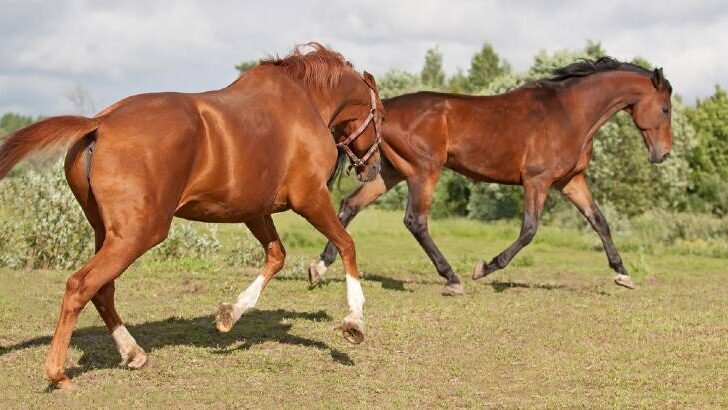Affiliate Disclaimer
As an Amazon Associate I earn from qualifying purchases. It helps me keep the website going. Thank you for your support.
Being able to understand equine behavior is an essential skill for anyone involved with horses. One significant aspect of horse behavior is dominance, which plays a vital role in herd dynamics. Some horses are more dominant than others, and recognizing signs of dominance in horses helps us stay safe around them. It also helps us build relationships with them, by communicating with them in their language.
The signs of dominance in horses include behaviors like herding, pinning the ears back, biting, and kicking. Dominant horses also have a more confident posture and attitude, and hold more eye contact than submissive horses. Dominant behavior plays a vital role in herd dynamics; with the herd leader being a naturally more dominant horse. Knowing how dominant a horse is helps us to handle and train the horse in a safer manner.
Understanding equine behavior, and signs of dominance, can take time to start with. Read on to learn more about dominant behavior in horses.
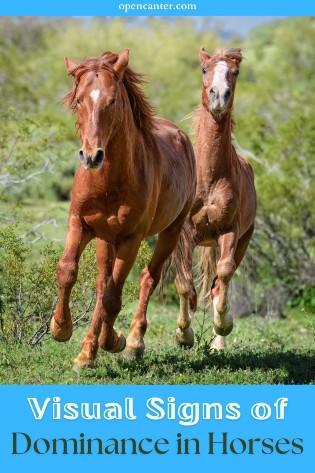
What Are The Signs of Dominance in Horses?
Horses communicate primarily through body language. The way that they move their ears, nostrils, and body communicates messages to other horses. Horses do use vocalization, however not nearly as often as we might think.
When looking at signs of dominance in horses, most of the key signs are linked to parts of the horse.
Ears
The way a horse holds its ears is one of the more obvious indicators of mood. More dominant horses will often hold their ears more forward or pricked. This is because as a leader, they are responsible for listening for danger.
Ears are also part of aggressive behavior. Dominant horses will pin their ears back at another horse to exert control. The ears appear as though they are ‘pinned down’ to the top of the head. This is usually seen when the dominant horse is forcing another horse to move out of the way.
Eyes
Direct eye contact is a key visual sign of dominance in horses. Dominant horses will maintain eye contact with subordinate horses, using this gesture to maintain authority. Subordinate horses may avert their gaze or lower their eyes as a sign of submission and respect.
Eye contact is a very subtle dominating behavior. This is likely the behavior that is being used when the dominant horse approaches and the others simply move out of the way. The dominant horse uses eye contact to make the other horses move.
Posture
Dominant horses carry themselves with an air of confidence and authority. They generally hold their head higher and move with more self-assurance. They protect their own space bubble and have no hesitations about entering the space of others.
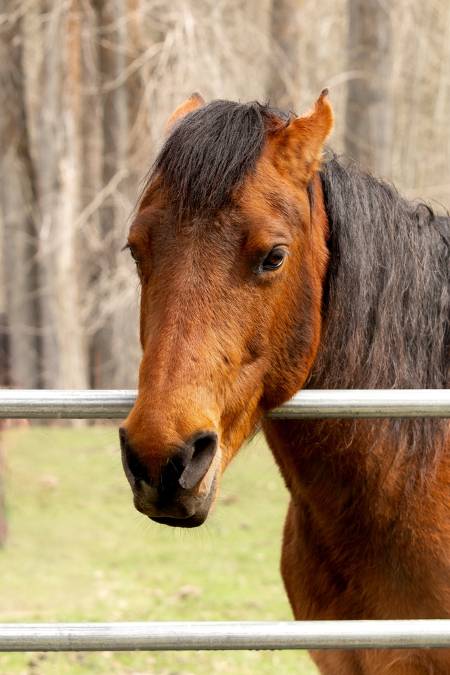
What Are The Dominant Behaviors in Horses?
Just like horses use their body language to establish dominance, they also have a variety of dominant behaviors. Horses use these behaviors in different scenarios to either establish or maintain dominance.
These behaviors include biting, kicking, pawing, rearing, or striking. In extreme cases, these behaviors are used in fights between two dominant horses. This can be seen in wild horse herds when two stallions fight over the leadership of a herd.
These behaviors can result in serious injury. A well-placed strike or kick can cause serious damage. Bites can most certainly draw blood!
Lastly, dominant horses can use space invasion behaviors to exert control over other horses. These behaviors include driving, herding, charging, crowding, and pushing. All of these behaviors are linked to the dominant horse making the other horse move.
Dominant horses may also seek to exclude a certain horse from the group. This can happen when a new horse is introduced to an already-established herd. The dominant horse will drive the new horse away from the group. They may also ‘patrol’ around the edges of the herd to prevent the new horse from rejoining the group.
Similar behaviors are also seen when it comes to feed time. Dominant horses can make other horses move away from food, which can lead to ‘musical chairs’ over feed stations. Dominant horses likely won’t let any other horses share their food pile.

How Do You Recognize The Signs of Dominance in Horses?
All you need to do to recognize the signs of dominance in horses is to simply watch. The best places to observe are during groundwork sessions or when the horse is in the field with herd mates. There are several key things to look out for…
Signs to Look Out For
- Watch for repeated displays of confident and assertive body language.
- Observe how horses interact at feed time – more dominant horses usually establish priority access to food and may chase others away.
- Keep an eye on which horses dominate their own space bubble, and which horses just simply move out of the way.
- Watch which horse decides where the herd stops to rest, and where they graze.
- A similar interaction occurs between horse and trainer – does the horse move out of the trainer’s space, or the other way around?
Sometimes, identifying dominant behavior can be quite difficult. This is because, in well-established herds, there is already a pecking order. This means that excessive dominant behavior is not required, as all the horses already know their place.
In these scenarios, you are unlikely to see obvious behaviors like charging, biting, or pinning the ears. Instead, more subtle body language is used, like eye contact. It can take some time to learn how to spot this behavior accurately.
It can also be easy to confuse play and dominant behavior. Sometimes horses will play fight, which looks a lot like real fighting! Play fighting might involve games of chasey, rearing up at each other, nipping or pulling on rugs or fly masks.
The key difference between play fighting and dominant behavior is how consistent the behavior is. When two horses play, either one can initiate, and there is no clear ‘attacker’.
You will know there is a problem when the dominant horse will not let the other take a break. While the submissive horse tries to move away, the dominant horse may continuously approach them. The behavior also doesn’t appear to be reciprocated by the submissive horse; unless in self-defense.
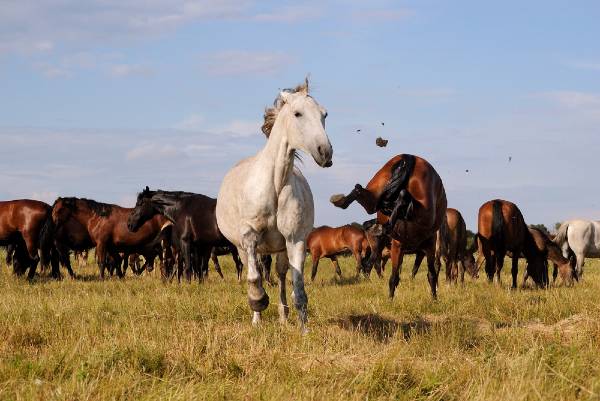
Why is it Important To Be Able To Read Horse Body Language?
Being able to read equine body language is an important skill for all horse owners. Firstly, it is what helps keep us safe when we are around horses. If we can read equine body language, we can gain an understanding of how the horse is feeling.
In the case of dominant behavior, it is important to be able to identify when a horse is directing this behavior toward you. If this happens, it indicates that the horse does not see you as their leader. Instead, they are trying to establish themselves as your leader.
This can become very dangerous, very quickly. Because horses are much bigger and stronger than humans, they can very easily injure us. Dominant behavior that starts with pinning the ears back may escalate to charging and biting.
This makes the horse very difficult to handle and greatly increases the risk of injury. If you are able to recognize the signs of dominance in horses, you will be able to prevent this from occurring.
A knowledge of equine body language also helps with horse training. Understanding if your horse is a dominant or submissive horse will help you choose the right training techniques. A more dominant horse requires a confident leader; whereas a more submissive horse may require a softer approach.
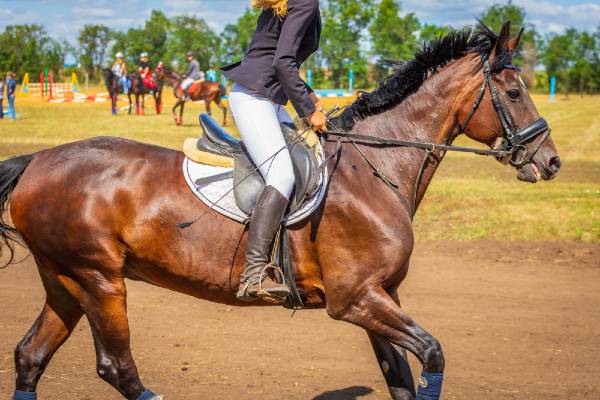
Do All Horses Use The Same Signs of Dominance?
Generally speaking, all horses use the same signs of dominance. However, the level of dominance that is displayed depends on the individual horse and situation.
For example, a naturally dominant horse in a well-established herd might only display minor dominant behavior. This is because all the horses already know each other and where they fit in the pecking order.
In these situations, there is a limited need for great displays of dominance. So long as the subordinate horses don’t challenge the leader, all remain in harmony. There might be the odd squabble over food or a favorite resting place, but this is usually quick to resolve.
However, when a new horse is introduced, you are much more likely to see the visual signs of dominance on display. Depending on how dominant the new horse is, they need to learn where they fit in with the existing herd.
The existing herd leader will use dominant behavior to establish their position as leader to the new horse. If the new horse is also dominant, the two may squabble for some time until a new pecking order is established.
This can vary from squealing, space invasion, and ear-pinning to chasing, biting, and kicking. This is why it is important to take equine introductions slowly. Always make sure you are able to supervise the introduction and monitor the horses for the next few days.
Final Thoughts
Being able to recognize the signs of dominance in horses is an important skill for any horse owner. Identifying behaviors like staring, herding, biting and space invasion helps keep you and other horses safe. Understanding how horses communicate through body language also makes it easier to interact with and train your horse.

